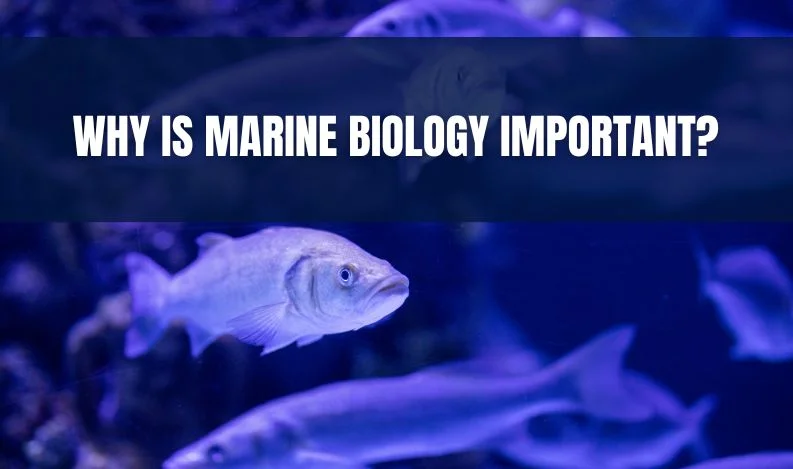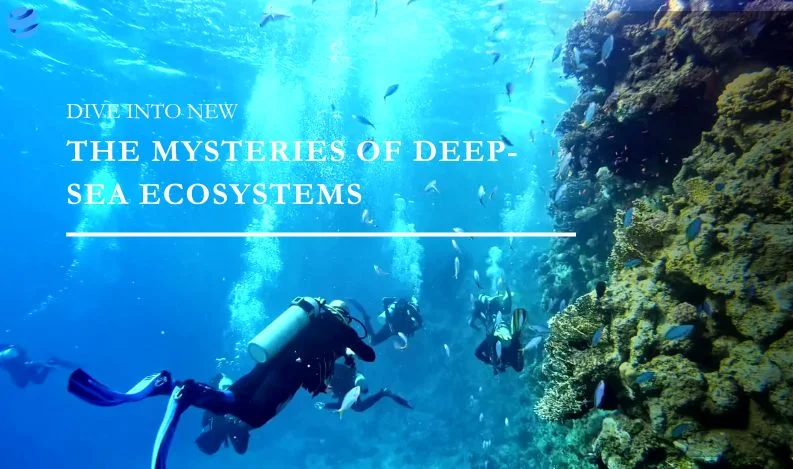The deep sea is one of the most mysterious and least explored places on Earth. It is a dark and cold world that lies far below the ocean's surface. Despite its harsh conditions, the deep sea is teeming with life. This blog will take you on a journey to explore the wonders of deep-sea ecosystems and the fascinating field of marine biology. We will use simple language and a formal tone to make this information easy to understand, even for young readers.
What is the Deep Sea?
The deep sea begins at a depth of about 200 metres and can extend down to more than 11,000 metres. The deeper you go, the less light there is. At the deepest parts, known as the abyssal and hadal zones, it is completely dark. The pressure is also incredibly high, and the temperatures are near freezing.
Zones of the Deep Sea
The deep sea is divided into different zones based on depth:
Mesopelagic Zone (200 to 1,000 metres): Also known as the twilight zone, this area receives very little light. Many fish here have large eyes to see better in the dim light.
Bathypelagic Zone (1,000 to 4,000 metres): Known as the midnight zone, this area is completely dark. The only light comes from bioluminescent creatures.
Abyssopelagic Zone (4,000 to 6,000 metres): This is the abyss. It is pitch black, very cold, and has high pressure.
Hadalpelagic Zone (6,000 metres to the ocean floor): This zone includes the deepest parts of the ocean, such as ocean trenches. It is named after Hades, the Greek god of the underworld.
Importance of the Deep Sea
The deep sea plays a crucial role in the Earth's ecosystem. It helps regulate the planet's climate by storing carbon dioxide. It is also home to many unique and undiscovered species. Studying the deep sea can help us understand the history of life on Earth and how organisms adapt to extreme environments.
Life in the Deep Sea
The deep sea is home to many strange and wonderful creatures. These creatures have evolved unique adaptations to survive in the harsh conditions of the deep sea.
The Anglerfish
The anglerfish is one of the most famous deep-sea creatures. It has a large mouth filled with sharp teeth. The most distinctive feature of the anglerfish is the bioluminescent lure that hangs from its head. This lure attracts prey in the dark waters. When an unsuspecting fish comes close, the anglerfish snaps it up with its powerful jaws.
The Giant Squid
The giant squid is another remarkable deep-sea creature. It can grow up to 12 metres long. The giant squid has large eyes, the largest in the animal kingdom, to help it see in the dark. It uses its long tentacles to catch prey. These tentacles are covered with suction cups, some of which have sharp hooks.
The Blobfish
The blobfish is a funny-looking fish that lives deep in the ocean. When it is out of water, it looks like a gelatinous blob. This is because it has very little muscle and is mostly made of a jelly-like substance. This adaptation helps it float just above the ocean floor, where it waits for food to come by.
Deep-Sea Corals
Deep-sea corals are different from the corals found in shallow, sunny waters. They do not rely on sunlight and photosynthesis. Instead, they feed on tiny particles that drift down from the upper layers of the ocean. Deep-sea coral reefs provide habitat for many other organisms.
Hydrothermal Vent Communities
Hydrothermal vents are found on the ocean floor where tectonic plates are moving apart. These vents release hot, mineral-rich water. Despite the extreme conditions, hydrothermal vents are teeming with life. Giant tube worms, clams, and shrimp thrive in these areas. These organisms rely on chemosynthesis, a process where bacteria convert chemicals from the vents into energy.
How Do Creatures Survive in the Deep Sea?
Surviving in the deep sea is not easy. It is dark, cold, and the pressure is immense. However, deep-sea creatures have developed special adaptations to survive.
Bioluminescence
Many deep-sea creatures can produce their own light, a phenomenon known as bioluminescence. This light is produced by chemical reactions within the organism. Bioluminescence serves many purposes. Some creatures use it to attract prey, like the anglerfish. Others use it to find mates or to communicate. Some even use it to scare away predators.
Big Eyes
To see in the darkness of the deep sea, many creatures have developed large eyes. The giant squid, for example, has eyes as big as dinner plates. These large eyes allow them to detect the faintest light and spot prey or predators from a distance.
Slow Metabolism
Food is scarce in the deep sea, so many creatures have a slow metabolism. This means they do not need to eat much and can survive on very little food. Some deep-sea fish can go for months without eating.
Special Body Structures
Deep-sea creatures often have special body structures to cope with high pressure. For example, the blobfish has a body made mostly of a gelatinous substance. This helps it withstand the crushing pressure of the deep sea.
Marine Biology
Marine biology is the study of life in the ocean. Marine biologists study all kinds of sea creatures, from tiny plankton to large whales. They also study the environments where these creatures live, including coral reefs, mangroves, and the deep sea.
The Role of Marine Biologists
Marine biologists play an important role in understanding and protecting the ocean. They discover new species, study how sea creatures live and interact, and investigate the impacts of human activities on marine ecosystems. Their work helps us understand the ocean and find ways to protect it.
Tools Used by Marine Biologists
Marine biologists use many tools to study the ocean. Some of these tools include:
Submarines and Submersibles: These vehicles allow scientists to explore the deep sea. They can go to great depths and withstand high pressure.
Robots and ROVs (Remotely Operated Vehicles): These are unmanned vehicles that can explore areas that are too dangerous or deep for humans. They are equipped with cameras and sensors to collect data.
Cameras and Sensors: Cameras are used to take pictures and videos of sea life. Sensors can measure things like temperature, pressure, and chemical composition of the water.
Nets and Traps: These are used to collect samples of sea creatures for study.
Why is Marine Biology Important?

Marine biology is important for many reasons. It helps us understand the ocean, which covers more than 70% of the Earth’s surface. It also helps us protect marine life. By studying marine ecosystems, we can learn how to keep them healthy. Marine biologists also help us understand the impact of pollution and climate change on the ocean.
Threats to Deep-Sea Ecosystems
Deep-sea ecosystems face many threats, most of which are caused by human activities. It is important to understand these threats so we can take action to protect the deep sea.
Pollution
Pollution is a major threat to the deep sea. Plastic waste, oil spills, and toxic chemicals can harm deep-sea creatures. Plastic waste can take hundreds of years to decompose. During this time, it can entangle animals or be mistaken for food, causing harm. Oil spills can poison the water, killing many organisms.
Overfishing
Overfishing is another significant threat. Many fish are caught faster than they can reproduce. This can lead to a decline in fish populations and disrupt the entire ecosystem. Some fishing methods, like deep-sea trawling, can also destroy habitats.
Climate Change
Climate change affects the deep sea in several ways. Warmer ocean temperatures can harm sea life that is adapted to cold water. The deep sea also absorbs a lot of carbon dioxide, which makes the water more acidic. Acidic water can dissolve the shells of sea creatures, making it hard for them to survive.
Deep-Sea Mining
Deep-sea mining is the process of extracting minerals from the ocean floor. This can destroy habitats and harm sea life. The noise and light from mining operations can also disrupt the behaviour of deep-sea creatures.
How Can We Protect the Deep Sea?
Protecting the deep sea is crucial for the health of our planet. There are many ways we can help.
Reduce Pollution
We can reduce pollution by recycling and using less plastic. It is important to dispose of waste properly and support clean-up efforts. Reducing the use of harmful chemicals and properly managing industrial waste can also help.
Sustainable Fishing
Practising sustainable fishing means catching fish in a way that does not harm the ecosystem. This includes using fishing methods that do not destroy habitats and setting limits on the number of fish that can be caught. Protecting endangered species is also important.
Support Marine Conservation
Supporting marine conservation organisations can make a big difference. These organisations work to protect the ocean through research, education, and advocacy. Donating to these organisations or volunteering your time can help support their efforts.
Raise Awareness
Raising awareness about the importance of the deep sea and the threats it faces can inspire others to take action. Education is key to fostering a sense of responsibility and stewardship for the ocean.
Policy and Legislation
Supporting policies and legislation that protect the ocean is crucial. This includes laws that regulate pollution, protect marine habitats, and promote sustainable fishing practices. Governments and international organisations play a vital role in enforcing these laws.
Conclusion
The deep sea is a fascinating and mysterious place. It is home to many unique and strange creatures. Marine biology helps us understand this hidden world. However, the deep sea is also fragile and faces many threats. By reducing pollution, practising sustainable fishing, supporting marine conservation, raising awareness, and supporting protective policies, we can help preserve the deep sea for future generations.
Exploring the deep sea reminds us of the wonders of nature and the importance of protecting our planet. Every small action we take can make a big difference in preserving the beauty and diversity of the deep-sea ecosystems. Let’s work together to ensure that this mysterious.
You may also like:-
Harnessing the Power of Social Media for Business Growth














